How Frank Lloyd Wright Architecture Revolutionized Creativity
Frank Lloyd Wright was more than an architect—he was a pioneer, a philosopher, and a creator whose work redefined how we live, interact with space, and think about the natural world. From his iconic designs, like the organic masterpiece Fallingwater, to the sweeping curves of the Guggenheim Museum, Wright continuously challenged the boundaries of conventional design. But it was not just his buildings that set him apart. His ideas about integrating life, nature, and architecture demonstrated a creative depth that went beyond structure, touching every aspect of modern living.
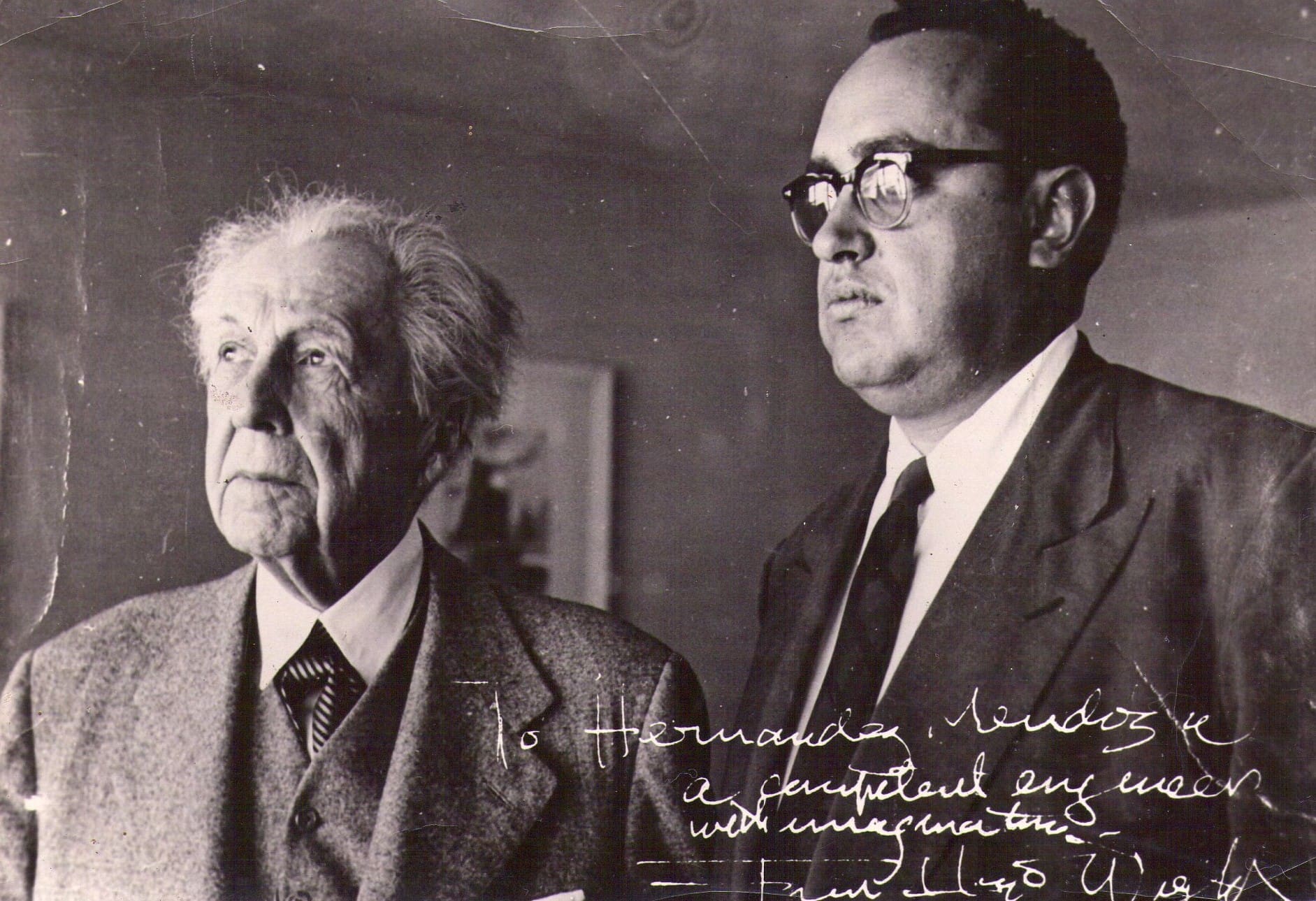
Frank Lloyd Wright with engineer José Luis Hernández Mendoza, autographed by Wright.
Image Source. License: Creative Commons Attribution-Share Alike 4.0 International (CC BY-SA 4.0).
“An architect’s most useful tools are an eraser at the drafting board and a wrecking bar at the site.” — Frank Lloyd Wright
What made Wright’s creativity so unique wasn’t just his vision of architecture but his ability to see the interconnectedness of design, nature, and humanity. His philosophy of “organic architecture,” buildings that live in harmony with their environment, was radical for its time and still serves as an inspiration for modern architects and creatives alike. This creativity wasn’t limited to construction materials or design forms. Frank Lloyd Wright architecture revolutionized and shaped the idea of architecture itself. He saw it not only as a means of shelter but as a complete art form—a total environment that shapes the lives of those who inhabit it. In much the same way, RIOT creative agency seeks to transform brands into immersive experiences, where every touchpoint feels thoughtfully crafted and integrated.
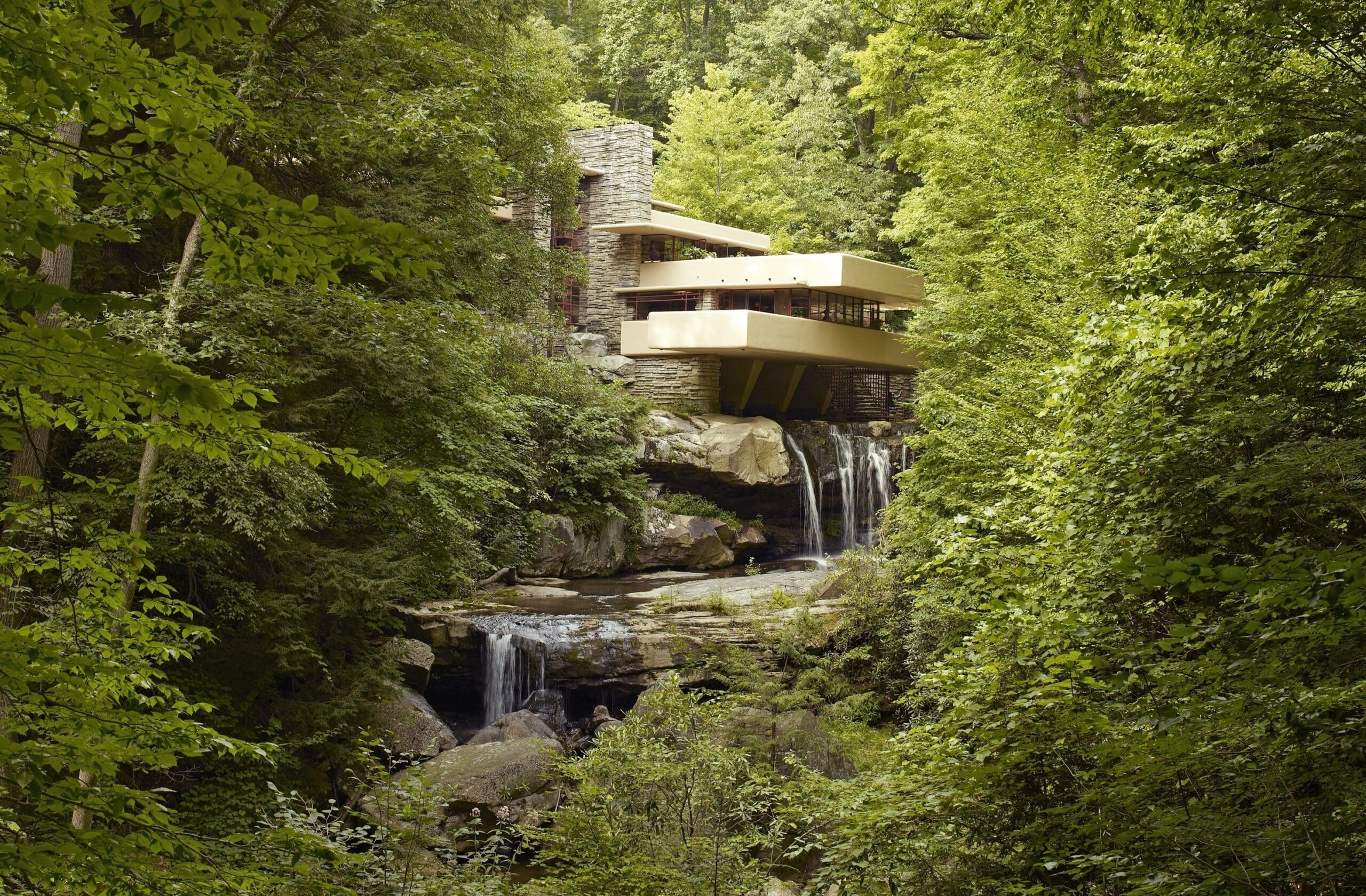
Fallingwater, one of Frank Lloyd Wright’s most famous architectural works, built over a waterfall in Pennsylvania. Photo by Carol M. Highsmith. Image Source. This work is from the Carol M. Highsmith Archive collection at the Library of Congress. According to the library, there are no known copyright restrictions on the use of this work.
Early Life and Inspirations
Wright’s early life was steeped in the landscapes of Wisconsin, where he was born in 1867, but his connection to nature and creative spirit can be traced even further back to his Welsh roots. Wright’s mother, Anna Lloyd Jones, came from a prominent Welsh family who had emigrated to the United States from Llandysul, Wales. The Lloyd Jones family brought with them a deep connection to nature, spirituality, and self-reliance—values that profoundly shaped Wright’s worldview. Wales, with its rugged landscapes and rich cultural heritage, was a strong influence on the Lloyd Jones family, and this legacy was passed on to Wright.
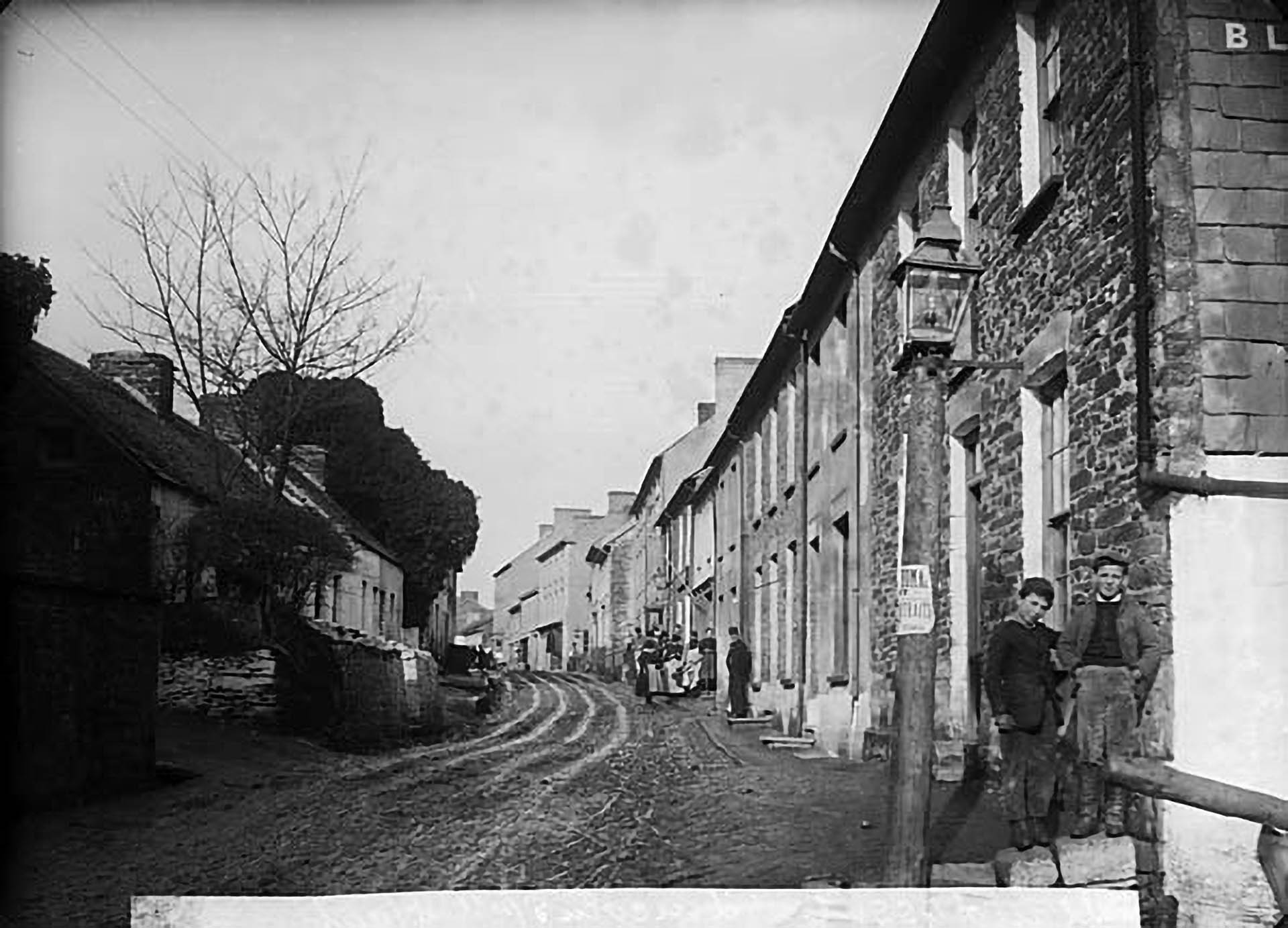
Historic view of Lincoln Street in Llandysul, Wales. Photo by the National Library of Wales.
Image Source. License: Public domain (Image courtesy of the National Library of Wales).
“I believe in God, only I spell it Nature.” — Frank Lloyd Wright
Growing up, Wright was surrounded by the natural beauty of the Wisconsin prairies, but his Welsh ancestry instilled in him a deep reverence for the land and a sense of hiraeth—a Welsh term that refers to a nostalgic longing for a homeland or a deep connection to a place. This connection to the land became a cornerstone of his architectural philosophy, where buildings should not just sit upon the land but become part of it. Wright once said, “Study nature, love nature, stay close to nature. It will never fail you,” reflecting the influence of his Welsh roots on his belief in living harmoniously with nature.
Anna Lloyd Jones, who firmly believed her son was destined to be an architect, decorated his nursery with images of cathedrals and other grand structures even before he was born. This early encouragement planted the seeds of his architectural journey, and Wright would later recall these formative years as crucial to his lifelong love for natural forms and open spaces.
As a young man, Wright’s designs were heavily influenced by nature’s patterns and rhythms. The organic shapes of trees, flowing water, and landscapes deeply inspired him. His work under Louis Sullivan, often called the “father of skyscrapers,” also profoundly shaped his approach to architecture. Sullivan’s famous motto, “form follows function,” became a guiding principle for Frank Lloyd Wright architecture, though he would later adapt it into his own maxim: “form and function are one.” It was here, under Sullivan’s mentorship, that Wright began to develop his distinct style—one that melded practicality with art in ways the world had never seen before.
Wright’s creativity extended beyond architecture; he was also deeply influenced by music, particularly classical compositions by Beethoven. Wright once compared architecture to a symphony, saying, “Buildings, too, are children of Earth and Sun.” His love for music is reflected in the rhythm and flow of his designs, where spaces feel almost musical in their transitions. Just as Beethoven would layer movements in a symphony, Frank Lloyd Wright architecture layered materials, textures, and light to create buildings that resonate emotionally, not just functionally.
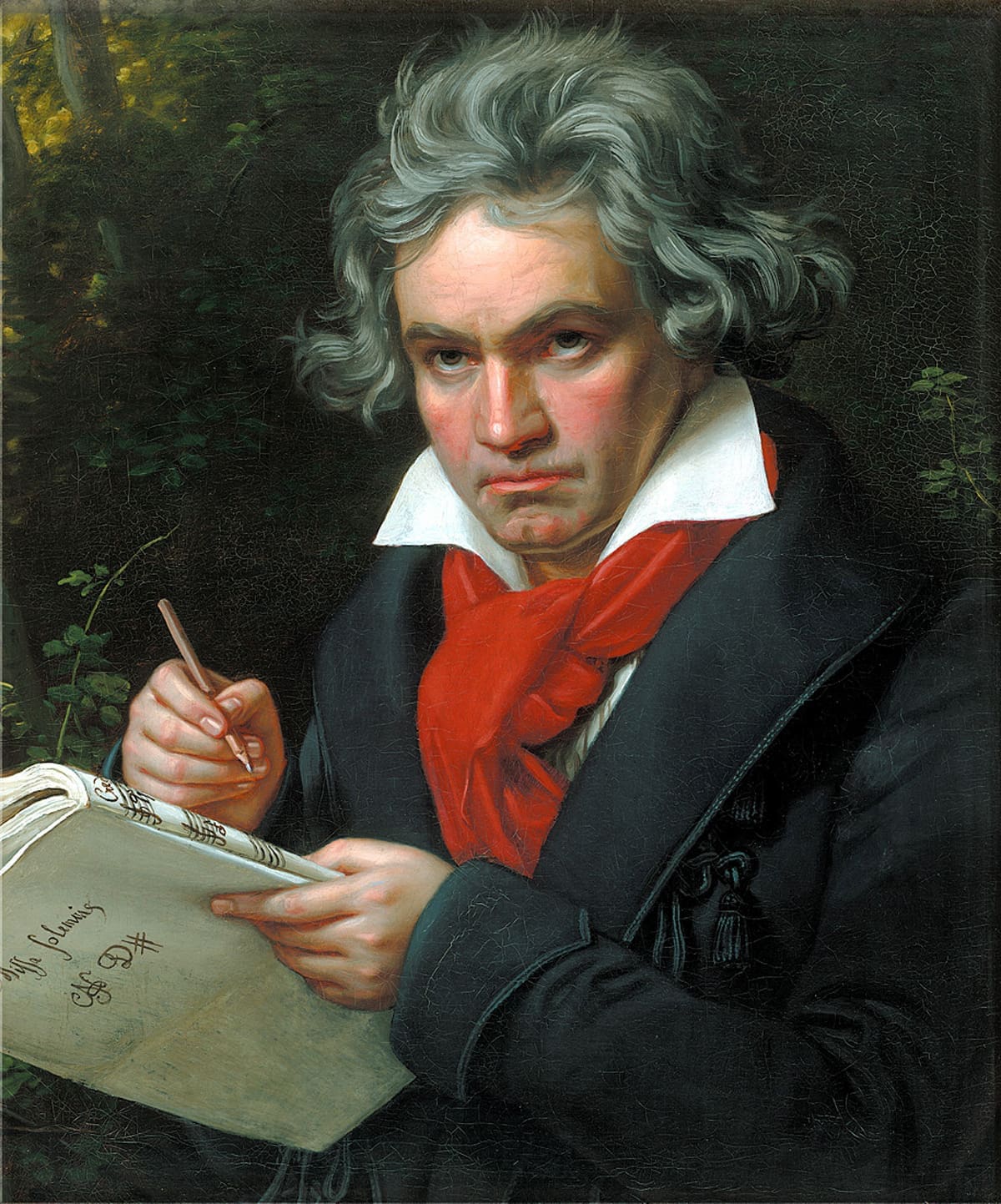
Portrait of Ludwig van Beethoven, painted by Joseph Karl Stieler in 1820. Beethoven is shown holding a musical score, symbolizing his enduring influence on classical music. Image Source. License: Public domain.
Wright’s belief that space could foster creativity was evident in his famous “music room” at Taliesin, where he would invite friends and musicians to perform. This idea of creating environments that enhance creative energy directly ties to RIOT’s approach, where environments are designed to foster innovation and inspiration at every turn. Much like Wright, RIOT creates spaces—physical and digital—that resonate beyond functionality and stimulate creativity.
Organic Architecture
Wright’s philosophy of “organic architecture” was the foundation of his life’s work. He didn’t simply design buildings; he sculpted them to become part of the natural environment, blurring the boundaries between the structure and its surroundings. His buildings don’t sit on landscapes; they emerge from them, like geological formations. This was a revolutionary idea at the time, one that rejected the rigid, disconnected architecture of the past in favor of something fluid, adaptable, and natural.
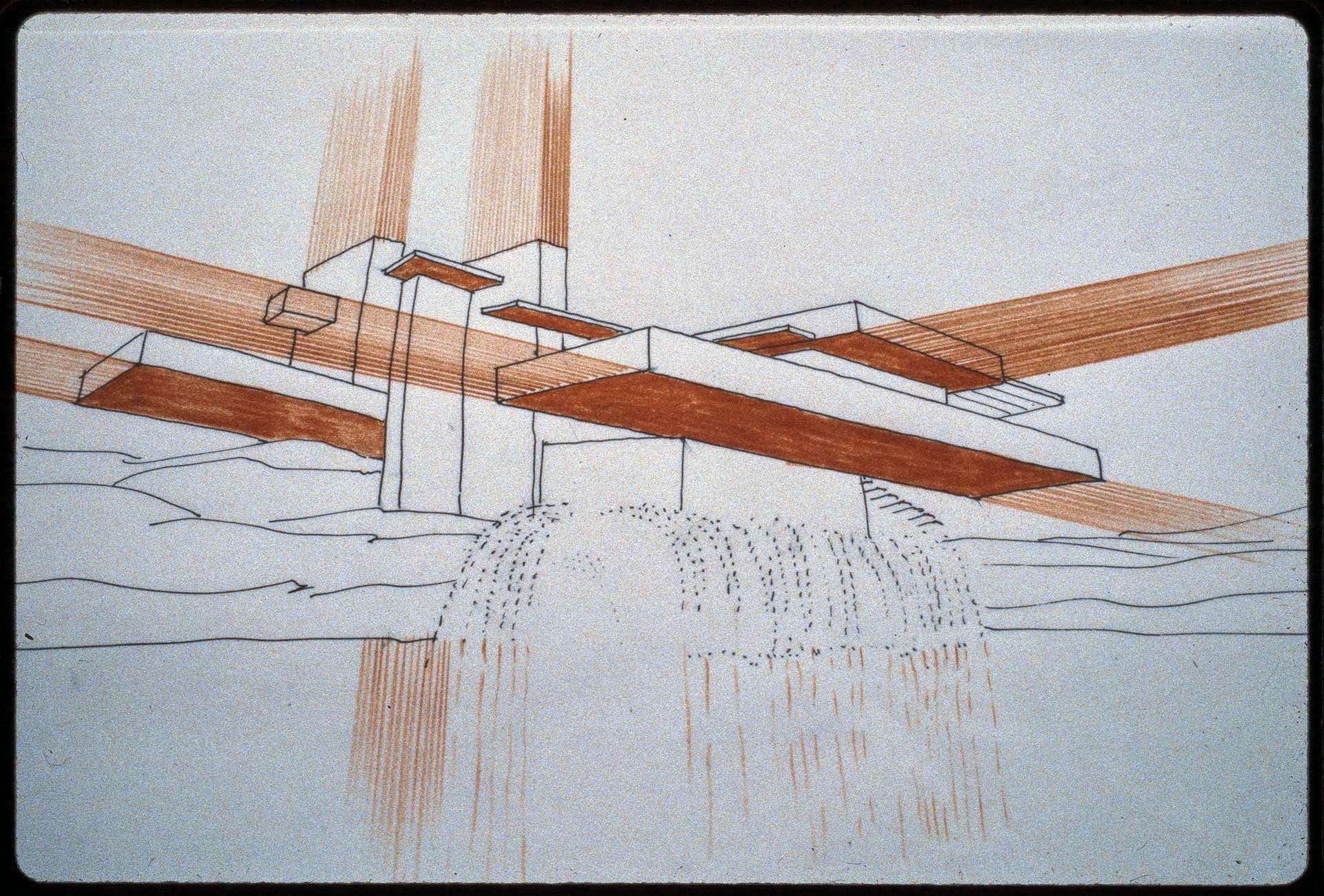
A 1935 architectural drawing of Fallingwater by Frank Lloyd Wright, illustrating the integration of the house with the waterfall. Drawing by Wright. Image Source: Library of Congress. License: Public domain.
Perhaps his most famous example of this philosophy is Fallingwater, a house designed in 1935 for the Kaufmann family. Situated over a waterfall in Pennsylvania, the home doesn’t merely blend with nature—it engages with it, becoming part of the ecosystem. Wright’s creative genius shines in every element of Fallingwater, from the cantilevered terraces that jut over the water to the way the sound of the rushing stream echoes throughout the house. “Fallingwater is a great blessing—one of the great blessings to be experienced here on earth,” Wright once said, emphasizing his belief in architecture as a life-enriching art.
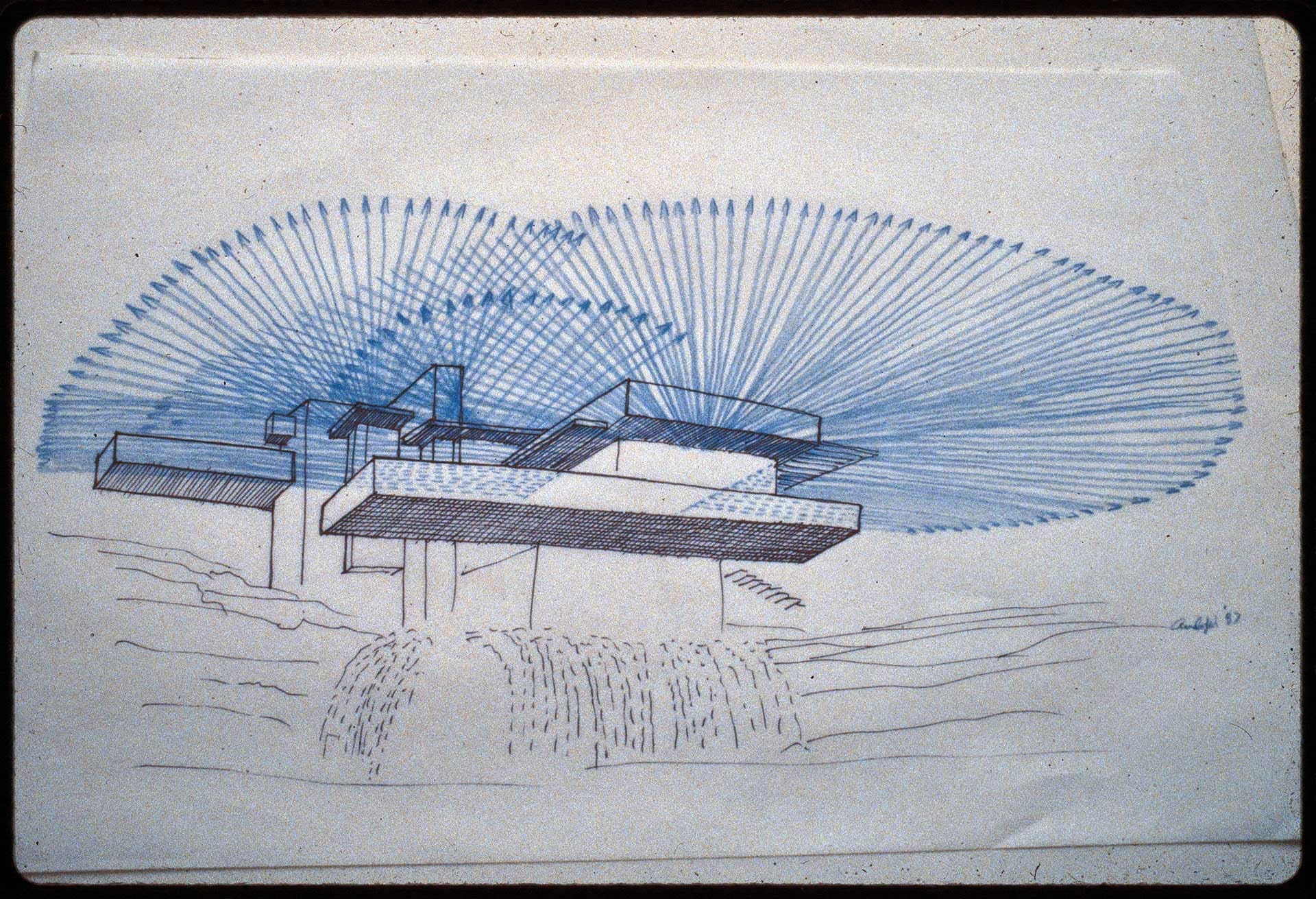
Architectural drawing of Fallingwater by Frank Lloyd Wright, showcasing his vision of the house integrated with the waterfall. Drawing from the 1930s. Image Source: Library of Congress. License: Public domain.
“No house should ever be on any hill or on anything. It should be of the hill. Belonging to it. Hill and house should live together, each the happier for the other.” — Frank Lloyd Wright
What’s surprising about Wright’s approach is how deeply he delved into not just the aesthetics of nature, but its underlying principles. He studied the geometry of plants, the flow of water, and the movement of air, translating these patterns into his designs. His fascination with natural geometry is seen in his use of hexagons and triangular forms in many of his buildings, such as the Hanna House. Wright didn’t just want his buildings to sit among trees; he wanted them to mimic the way nature constructs its own forms.
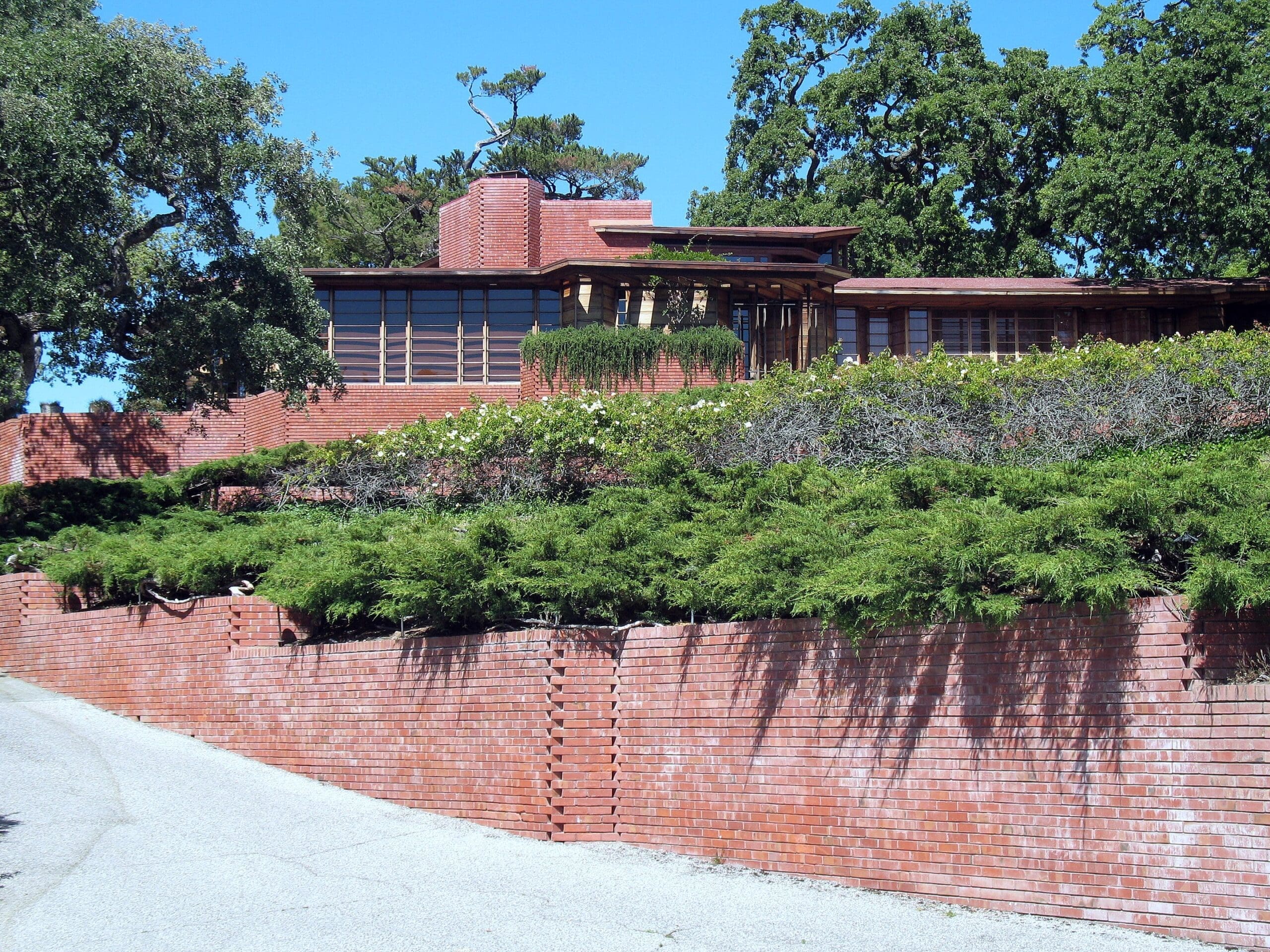
Hanna-Honeycomb House, designed by Frank Lloyd Wright in 1937, located in Palo Alto, California. This photo was taken in 2012. Image Source: Wikimedia Commons. License: Creative Commons Attribution-Share Alike 3.0 Unported (CC BY-SA 3.0).
Contemporary architects continue to draw inspiration from Wright’s organic principles. Renowned architect Tadao Ando, known for his minimalist, nature-oriented designs, often cites Frank Lloyd Wright architecture as an influence. Ando has said, “Wright’s architecture shows us how to make the environment an integral part of our lives. He was far ahead of his time.”
Creative Revolution: Wright’s Early 1900’s Creations
Wright’s work in the early 1900s revolutionized American residential architecture. Frank Lloyd Wright, alongside a group of talented architects, was a founder and the most influential figure in the development of Prairie-style architecture. His work revolutionized American residential design, creating buildings that reflected openness, simplicity, and harmony with their natural surroundings. His development of the Prairie style was a direct response to the Victorian-era houses that dominated the landscape at the time. These homes were boxy, overly ornate, and disconnected from the natural environment. Wright sought to change that by creating buildings that embodied openness, simplicity, and integration with their surroundings.
The Robie House, built in 1910, is one of the most iconic examples of the Prairie style. With its low, horizontal lines and open floor plan, the house was designed to reflect the flat, expansive prairies of the Midwest. Wright wanted his buildings to have “horizontal lines to make them belong to the earth,” rejecting the verticality of skyscrapers in favor of designs that seemed to stretch into the horizon. His use of long eaves and ribbon windows emphasized this horizontal flow, while his open interior spaces signaled a break from the cramped, segmented Victorian rooms.
What might surprise people is how Wright’s Prairie style laid the groundwork for modern minimalism. Wright believed in eliminating unnecessary elements, allowing the beauty of the structure and materials to shine through. This “less is more” approach, decades ahead of its time, influenced not only architects but also modern interior designers and creatives across disciplines.
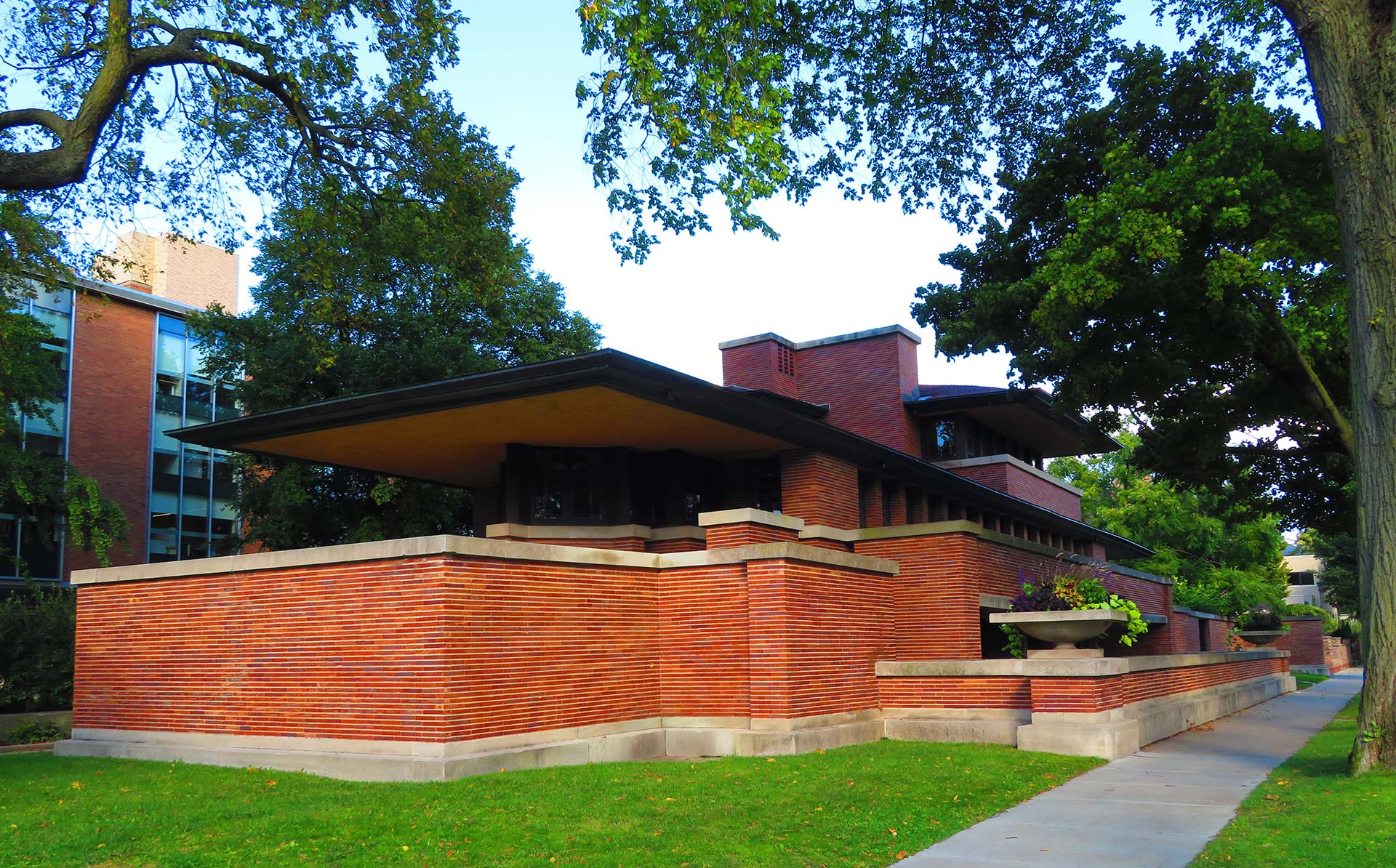
Frederick C. Robie House, designed by Frank Lloyd Wright in 1910, is one of the most iconic examples of Prairie School architecture. Located in Chicago, Illinois, it is celebrated for its bold horizontal lines and organic design. Image Source: Wikimedia Commons. License: Creative Commons Attribution-Share Alike 3.0 Unported (CC BY-SA 3.0).
“The mother art is architecture. Without an architecture of our own, we have no soul of our own civilization.” — Frank Lloyd Wright
Later in his career, Wright developed the concept of Usonian homes, affordable, functional houses designed for middle-class Americans. These homes, with their flat roofs, open plans, and built-in furniture, were a precursor to what we now recognize as modern suburban design or Mid Century Modern design as many know it. Wright once said, “A building should appear to grow easily from its site and shape itself to harmonize with its surroundings if Nature is manifest there.” Usonian homes exemplified this belief, being cost-effective yet artistically designed to merge with the landscape.
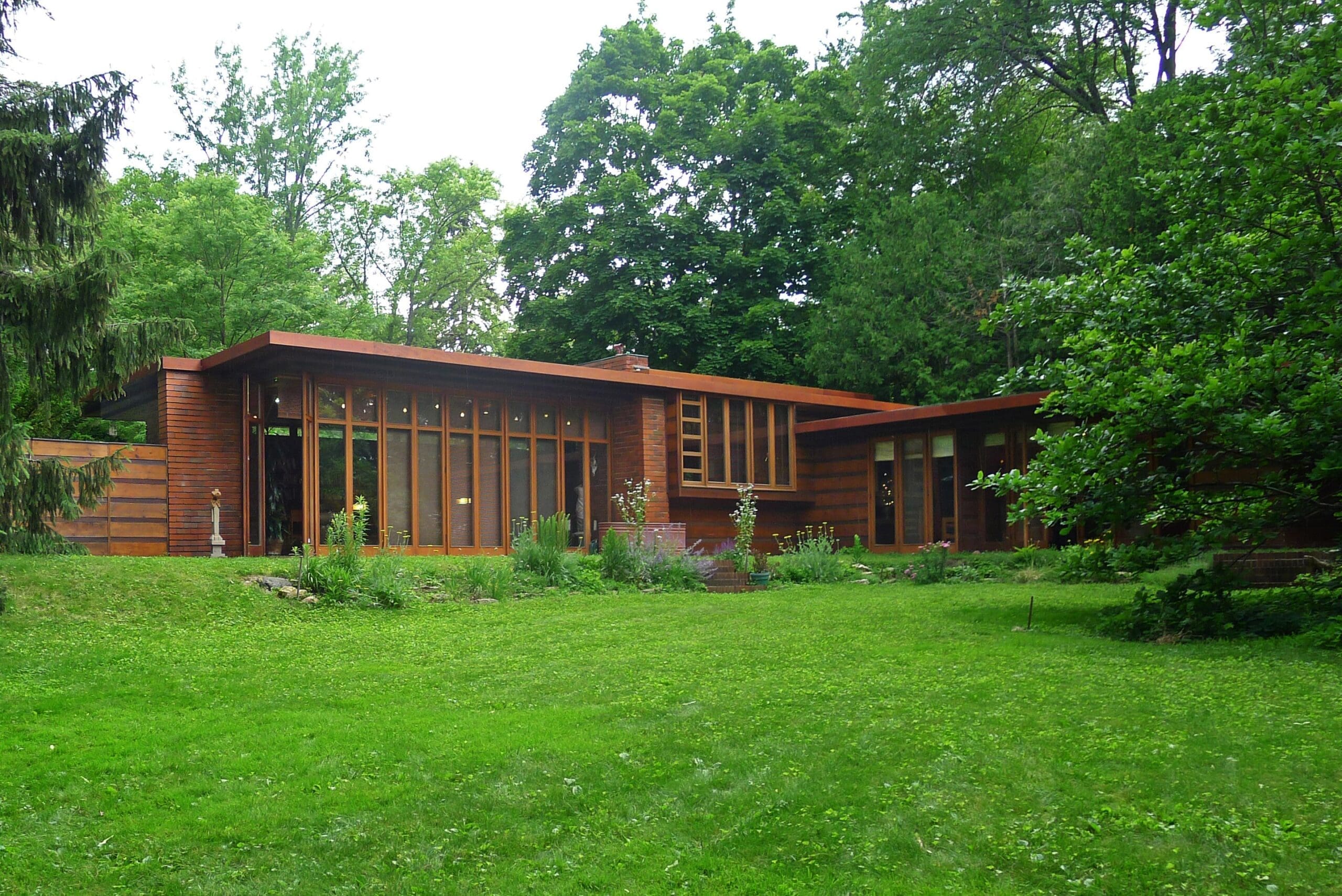
Jacobs First House, designed by Frank Lloyd Wright in 1937, is considered the first Usonian house. Located in Madison, Wisconsin, this house reflects Wright’s philosophy of affordable, functional, and beautifully integrated design. Image Source: Wikimedia Commons. License: Creative Commons Attribution-Share Alike 3.0 Unported (CC BY-SA 3.0).
Wright’s work on the Prairie and Usonian homes wasn’t just about his own designs; it also served as a platform for training future generations of architects. The Taliesin Fellowship, which Wright founded in 1932, was where he mentored young architects in the art of integrating form and function. His protégés, including architects like John Lautner and Richard Neutra, went on to create their own groundbreaking works, carrying forward the lessons they learned from Wright. Lautner, in particular, became known for his futuristic homes that echoed Wright’s organic design principles.
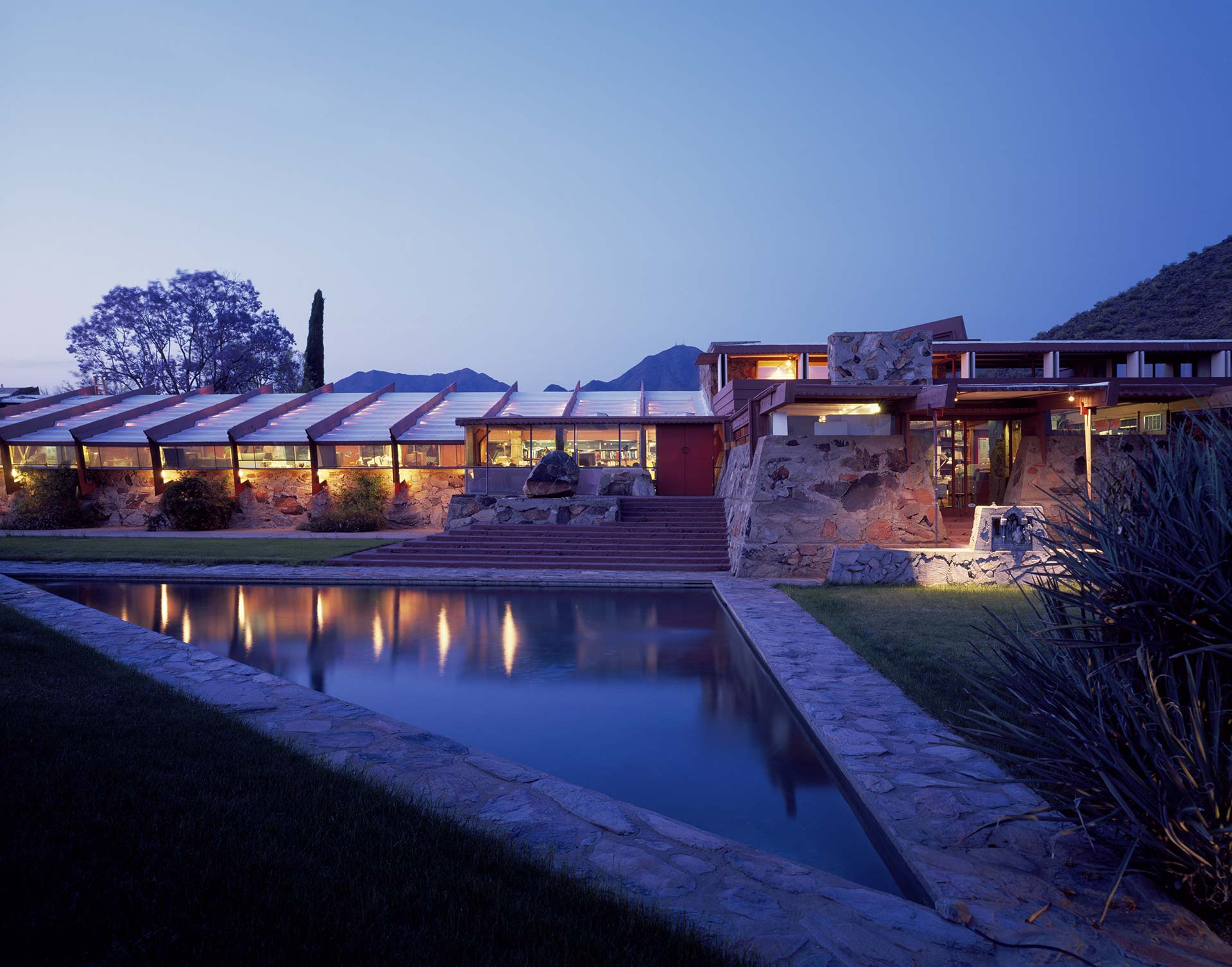
Taliesin West, designed by Frank Lloyd Wright, was his winter home and studio in Scottsdale, Arizona. It is considered one of his most important works, blending seamlessly into the surrounding desert landscape. Image Source: Wikimedia Commons. License: Public domain.
“Working with Frank Lloyd Wright was like learning architecture from the ground up, with no detail too small and no concept too large,” Lautner once said, capturing the intense mentorship Wright offered his students. Through this fellowship, Wright didn’t just leave behind buildings; he left behind a generation of architects imbued with his creative spirit, much like RIOT seeks to inspire and mentor future creatives in the art of holistic brand experiences. We found a fun article on Moby’s website that talks about how he has a Lautner guest house! Definitely worth having a quick Look.
Today, architects such as Bjarke Ingels and Thom Mayne credit Wright’s ideas of blending nature, simplicity, and accessibility as major influences on their own work. Mayne, known for his bold, unorthodox designs, has commented, “Wright taught us to think beyond the box, literally and figuratively.”
Shaping The Future
Frank Lloyd Wright was not just an architect of form but an innovator in function. He constantly experimented with new materials and construction techniques that pushed the boundaries of what buildings could do, often using materials that others in his time had yet to consider fully. From glass to steel to concrete, Wright’s mastery of these materials was not just technical but deeply artistic.
One of his earliest and most significant breakthroughs was his use of reinforced concrete. At a time when concrete was largely seen as an industrial material for bridges and dams, Wright recognized its potential for aesthetic and structural innovation. He used it to create bold, clean lines that allowed for new design possibilities. His Unity Temple, completed in 1908, was one of the first public buildings in America constructed from reinforced concrete, and it remains an icon of modernist architecture. Wright described it as “my contribution to modern architecture,” noting how the material allowed him to create unique spaces and experiment with light.
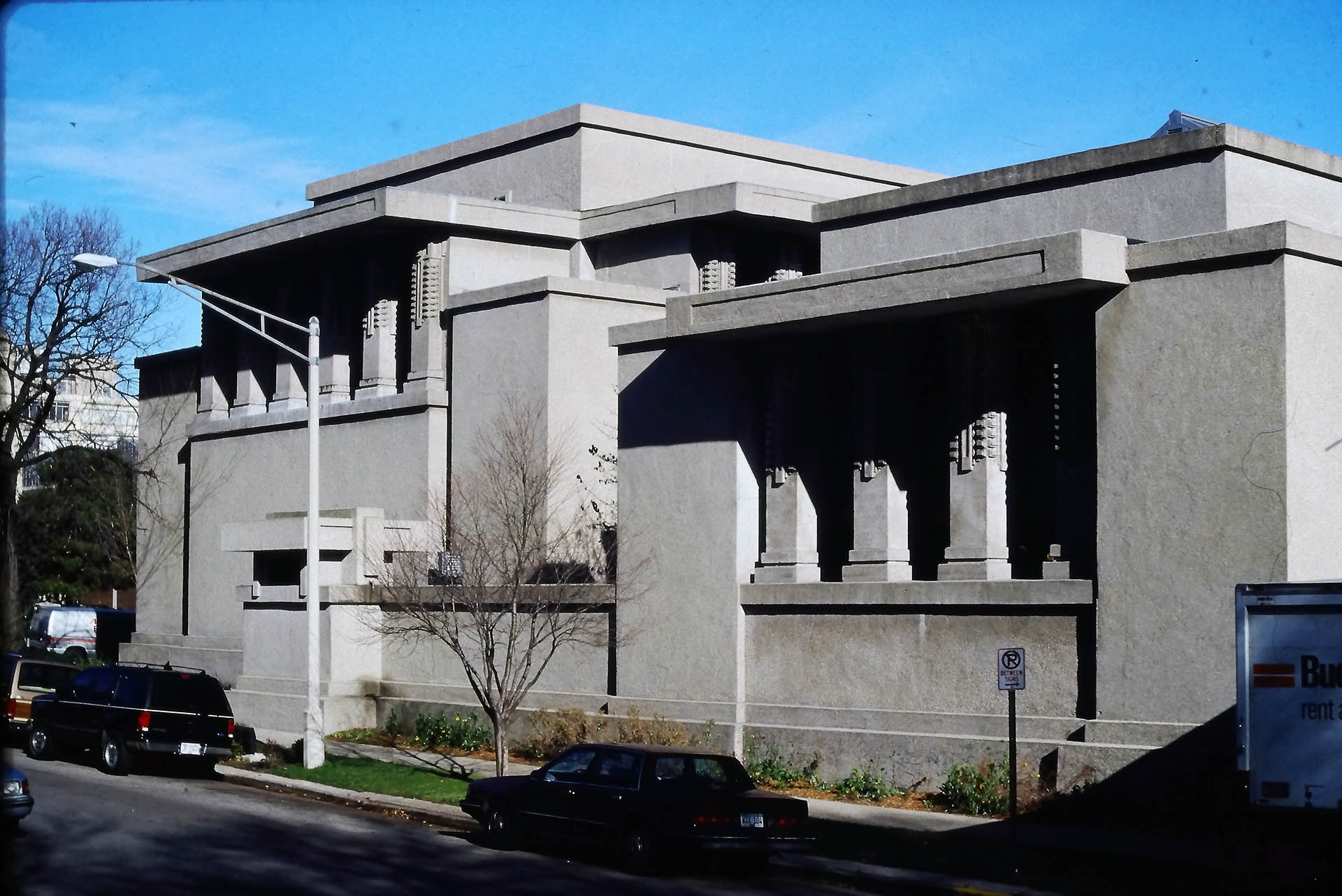
Unity Temple, designed by Frank Lloyd Wright in 1908, located in Oak Park, Illinois. One of the earliest examples of modern architecture, this building is constructed of reinforced concrete. Image Source: Wikimedia Commons. License: Creative Commons Attribution-Share Alike 4.0 International (CC BY-SA 4.0).
“The architect must be a prophet… a prophet in the true sense of the term… if he can’t see at least ten years ahead, don’t call him an architect.” — Frank Lloyd Wright
Wright’s innovative use of materials also extended to how they influenced spatial concepts. His breakthrough with cantilevers—where structures are supported on one end but free on the other—created vast open spaces within homes and buildings that were previously unthinkable. In Fallingwater, for example, cantilevers enabled the house to stretch out over the waterfall without needing vertical support. The flowing design of the terraces made the home feel as if it was floating above the landscape, blurring the lines between interior and exterior spaces.
This innovation wasn’t just structural; it was philosophical. Wright believed that the open spaces made possible by new materials would allow for more open living—both physically and mentally. He said, “Space is the breath of art,” expressing his belief that architecture should feel expansive and liberating, rather than confining.
Architect Jeanne Gang, known for her innovative use of materials in environmentally conscious buildings like the Aqua Tower in Chicago, often references Wright’s influence on her work. “Frank Lloyd Wright taught us to see the possibilities in materials that others overlook. His ability to make concrete and steel feel light and organic is something I aspire to in my own work,” Gang has said.
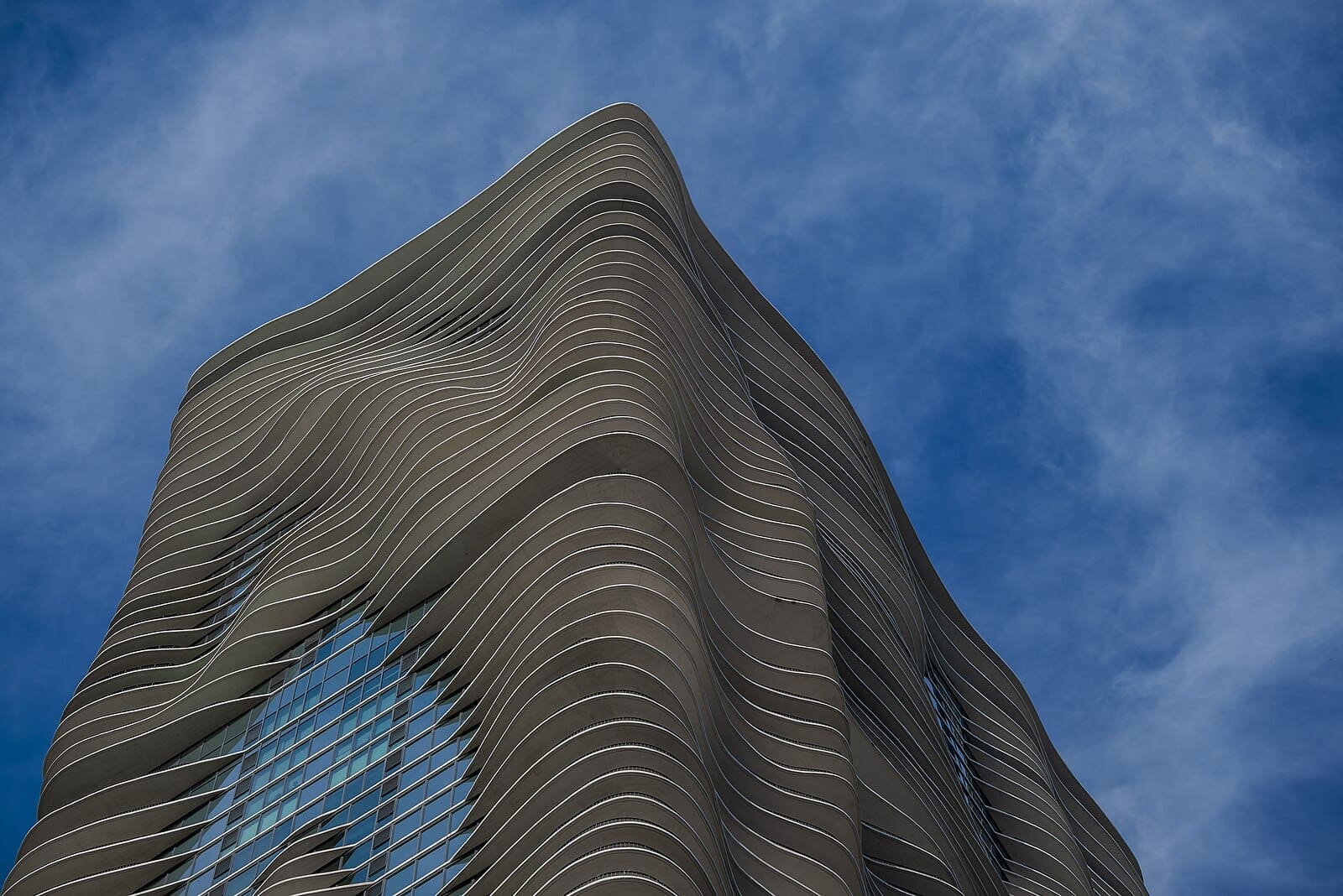
Aqua Tower, designed by Jeanne Gang and completed in 2009, is one of the most iconic examples of modern architecture in Chicago. Its wave-like design integrates nature with urban living a principle deeply influenced by Frank Lloyd Wright’s legacy. Image Source: Wikimedia Commons. License: Creative Commons Attribution-Share Alike 4.0 International (CC BY-SA 4.0).
Wright’s Philosophy of Total Design
Wright believed in what he called “total design”—a philosophy that saw architecture as encompassing not only the building itself but everything inside and around it. He didn’t just design buildings; he designed furniture, lighting, textiles, and even the landscape surrounding the structure. This approach ensured that every element of a project worked in harmony, creating a cohesive and holistic experience.
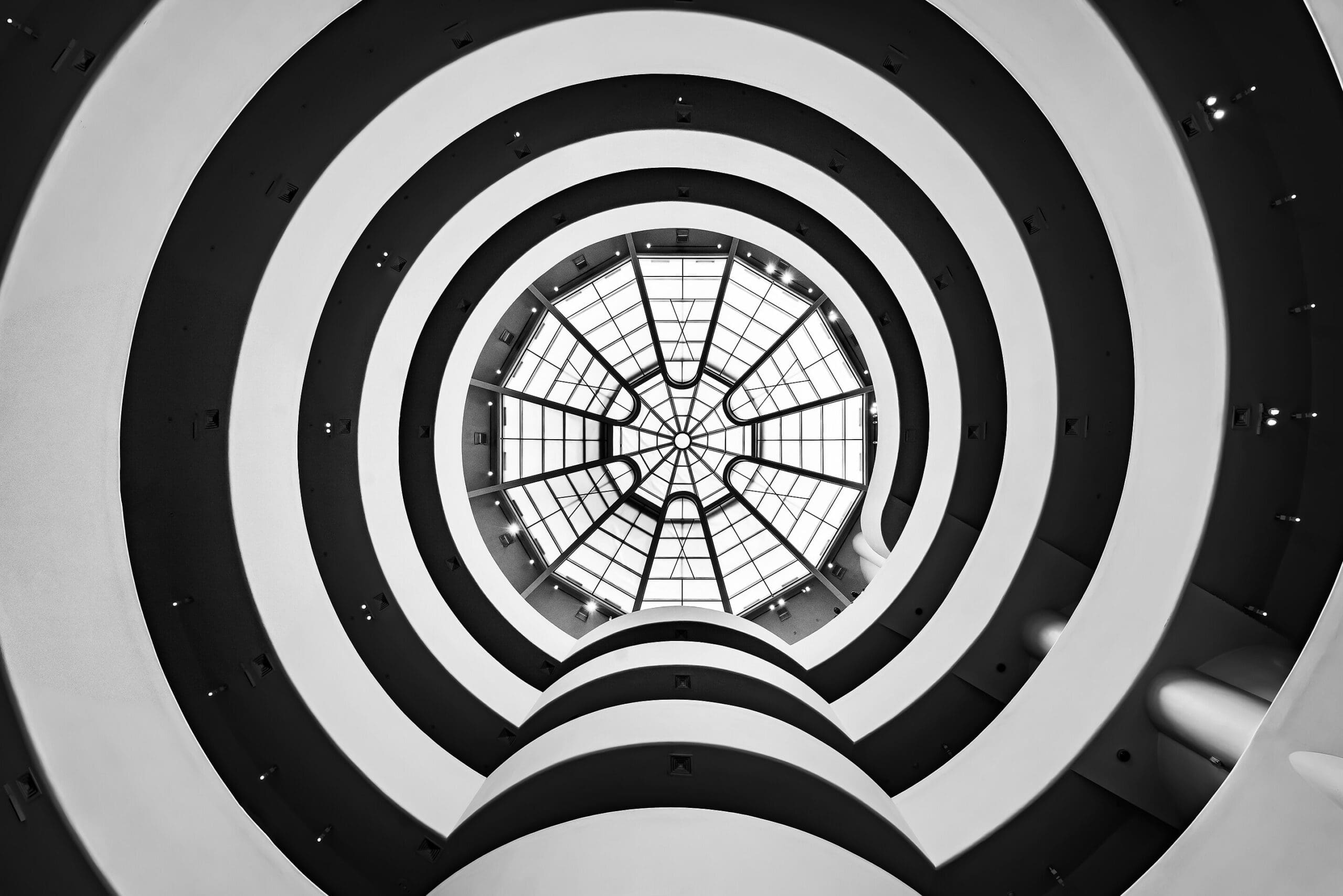
The iconic skylight of the Solomon R. Guggenheim Museum, designed by Frank Lloyd Wright in New York City, opened in 1959. The museum’s distinctive spiraling structure is a hallmark of modern architecture. Image Source: Wikimedia Commons. License: Creative Commons Attribution-Share Alike 3.0 Unported (CC BY-SA 3.0).
His Fallingwater house is a perfect example of this. Wright personally designed the furniture and selected the artwork to complement the organic architecture. He was famously meticulous, even designing the rugs and window treatments, so nothing in the house would distract from the natural surroundings or disrupt the flow of the design. Wright’s belief that “all great architecture is the design of the whole” was something he embodied in every project, from the smallest homes to massive public works like the Guggenheim Museum in New York.
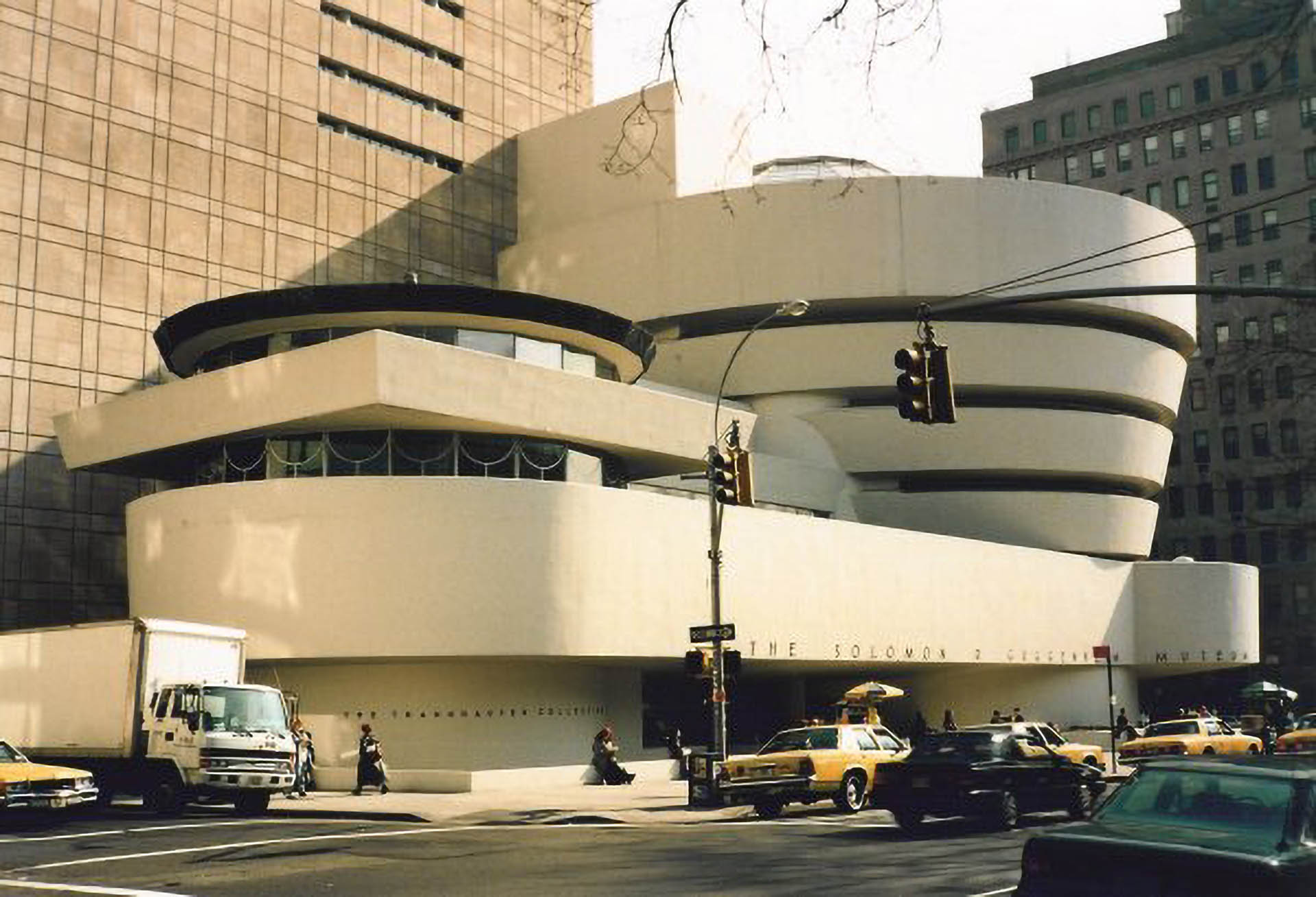
The Solomon R. Guggenheim Museum in New York City, designed by Frank Lloyd Wright and completed in 1959. This iconic building is a landmark of modern architecture, captured here in a 1995 photograph. Image Source: Wikimedia Commons. License: Creative Commons Attribution-Share Alike 3.0 Unported (CC BY-SA 3.0).
“A building is not just a place to be. It is a way to be.” — Frank Lloyd Wright
Frank Lloyd Wright’s Innovations
While Wright is best known for his buildings, his furniture designs were equally revolutionary. He often designed built-in seating and cabinetry as part of the architecture itself, removing the need for additional furniture that might clutter or disrupt the flow of the space. One surprising aspect of Wright’s creative legacy is his contribution to modern modular furniture. His Usonian homes often featured modular, geometric furniture pieces that could be reconfigured based on the needs of the homeowners—an idea that would later become central to modern furniture design.
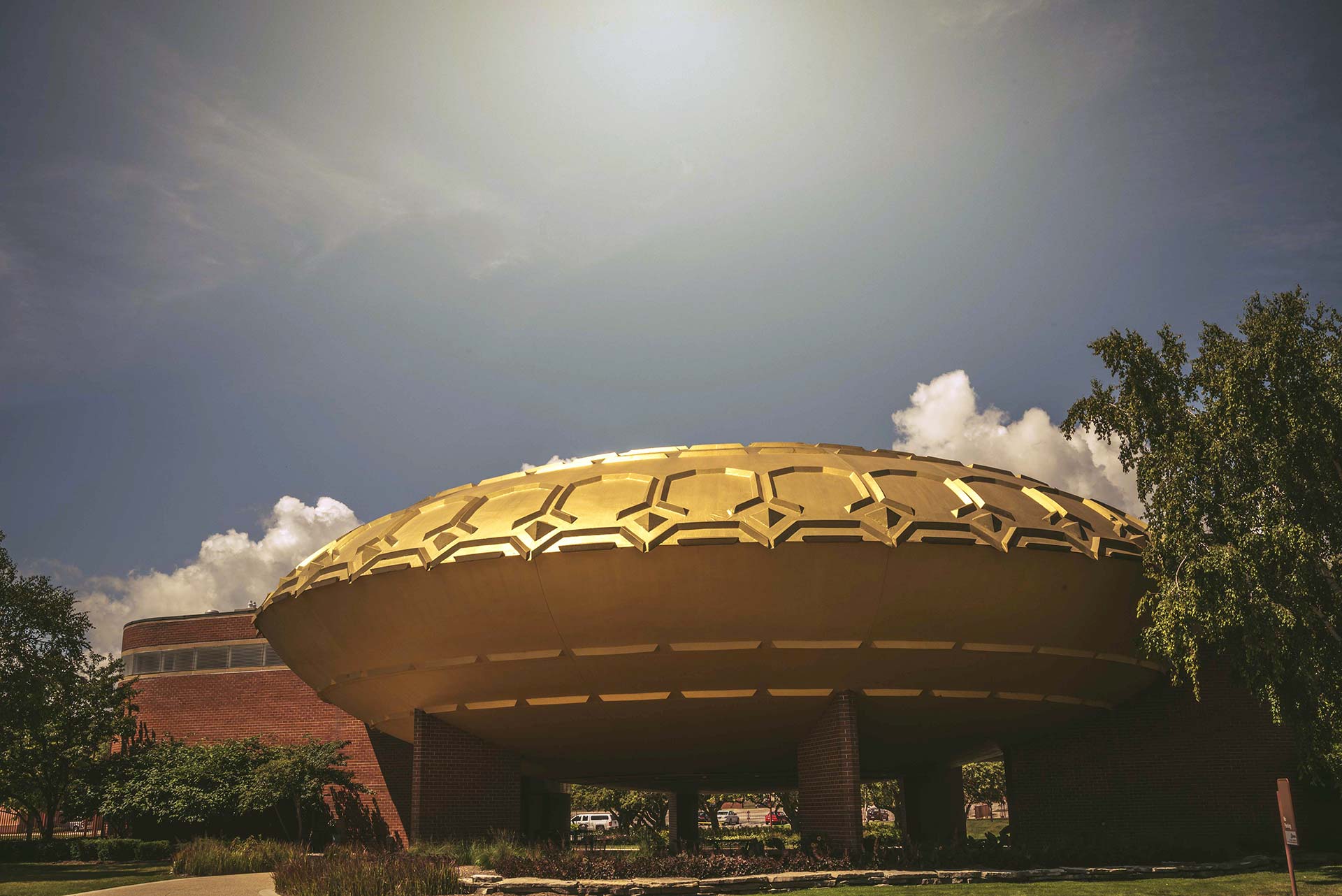
The Johnson Wax Golden Rondelle Pavilion in Racine, Wisconsin, originally designed by Frank Lloyd Wright for the 1964 World’s Fair, now serves as a visitor center for the SC Johnson campus. Image Source: Wikimedia Commons. License: Creative Commons Attribution-Share Alike 4.0 International (CC BY-SA 4.0).
Wright was a master of making the functional beautiful, blurring the line between furniture and architecture. In his Johnson Wax Headquarters, the famous “lily pad” columns not only serve as structural supports but also act as sculptural elements within the space. Wright believed that furniture should be an extension of the building itself, enhancing its harmony rather than standing apart.
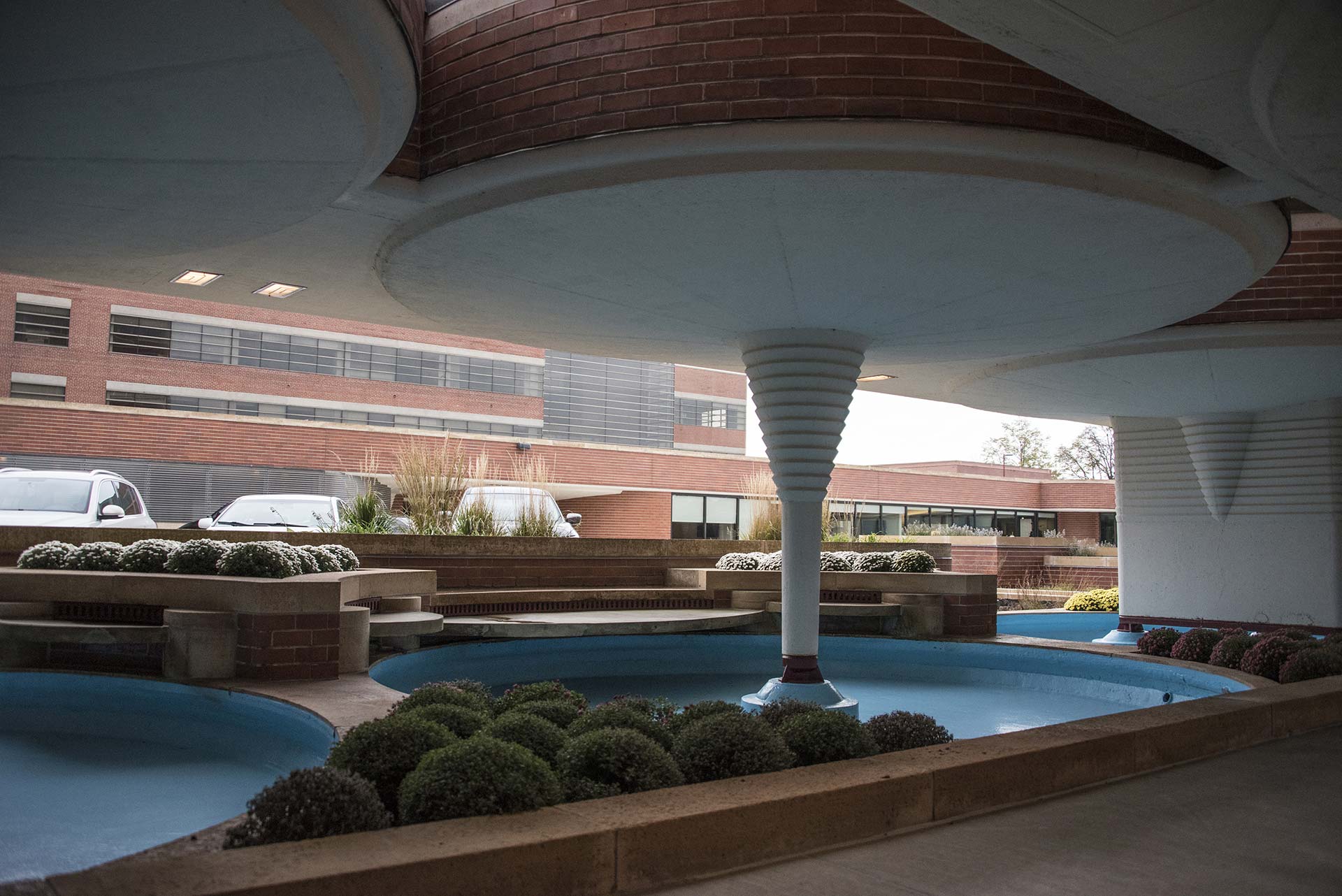
The SC Johnson Administration Building, designed by Frank Lloyd Wright and completed in 1939 in Racine, Wisconsin, is considered one of Wright’s most innovative office designs. Image Source: Wikimedia Commons. License: Creative Commons Attribution-Share Alike 4.0 International (CC BY-SA 4.0).
Mentorship and Passing the Philosophy On
Wright’s philosophy of total design was passed on to his students, most notably in the Taliesin Fellowship. Wright’s protégés, including architects like E. Fay Jones, took his principles and adapted them to their own work. Jones, who designed the famous Thorncrown Chapel in Arkansas, often spoke about how Wright’s total design approach inspired him to create spaces that felt like a complete, unified whole, blending architecture, nature, and human use into one seamless experience. “He taught us that you can’t just build a building and leave it at that. Every detail matters. Every chair, every window, every light—it’s all part of a greater design,” Jones once said about Frank Lloyd Wright architecture mentorship.
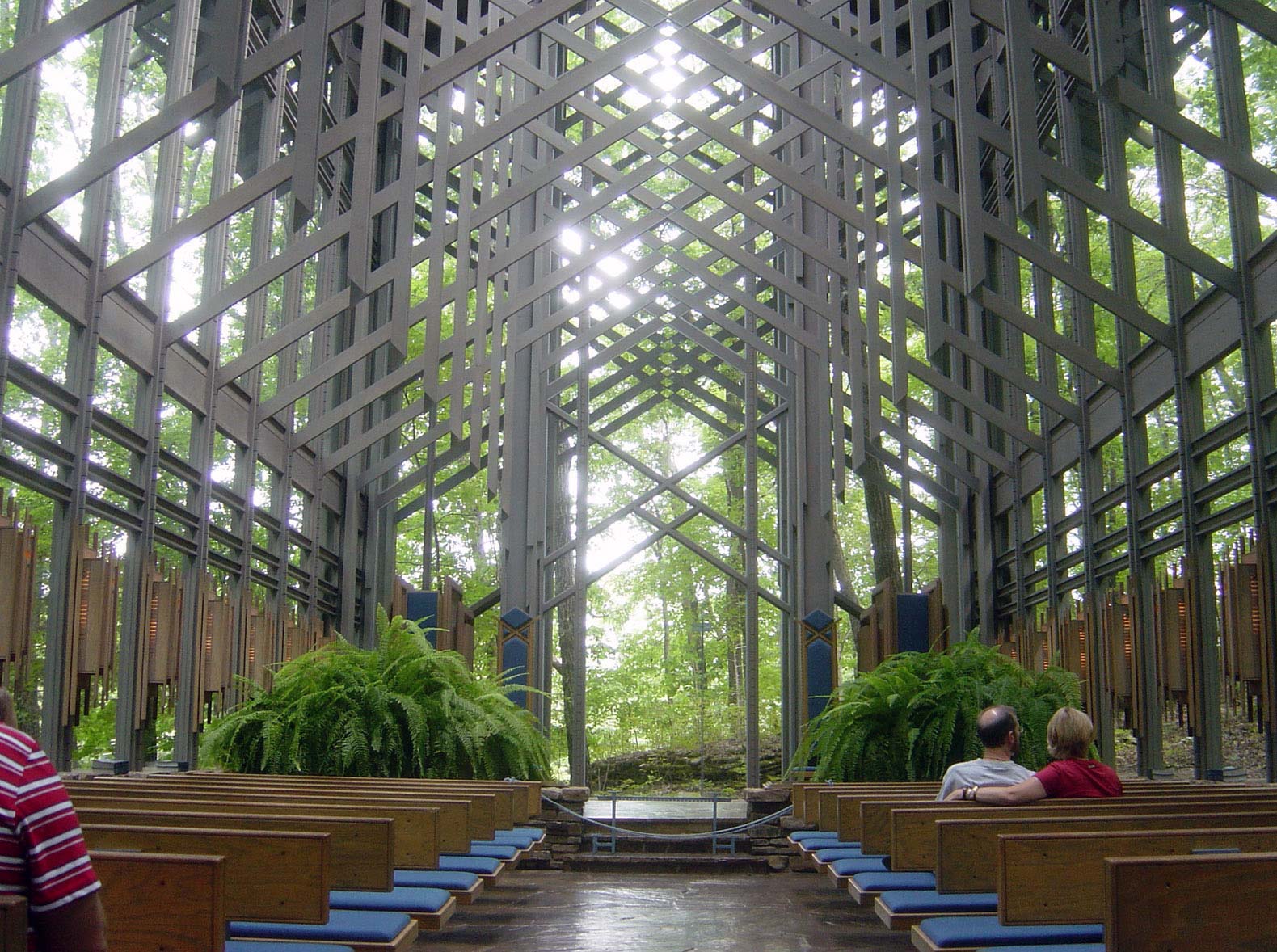
Thorncrown Chapel, designed by E. Fay Jones in 1980, is located in Eureka Springs, Arkansas. The chapel is famous for its integration with nature and its use of glass and wooden lattice structures. Image Source: Wikimedia Commons. License: Creative Commons Attribution-Share Alike 3.0 Unported (CC BY-SA 3.0).
Even today, designers across disciplines, from fashion to product design, are influenced by Wright’s total design philosophy. Legendary fashion designer Virgil Abloh referenced Wright’s approach in his own creative process, saying, “Wright taught us that design isn’t just about the object—it’s about the entire experience.” Abloh, known for blending art, architecture, and streetwear, saw Wright as a figure who embodied the intersection of multiple creative disciplines, much like RIOT does with our projects that blend design, media, and storytelling into a unified brand experience.
Frank Lloyd Wright’s Creative Approach
Frank Lloyd Wright wasn’t just an architect—he was a teacher and mentor to future generations of designers and creatives. His mentorship extended through the Taliesin Fellowship, an architectural apprenticeship program he founded in 1932, where students lived and worked alongside Wright. The Fellowship was more than just a school; it was a community where students were immersed in Wright’s philosophy, lifestyle, and vision of integrating creativity into every aspect of life. Wright taught his students to see architecture as an art form that went beyond construction, touching the realms of philosophy, nature, and human experience.
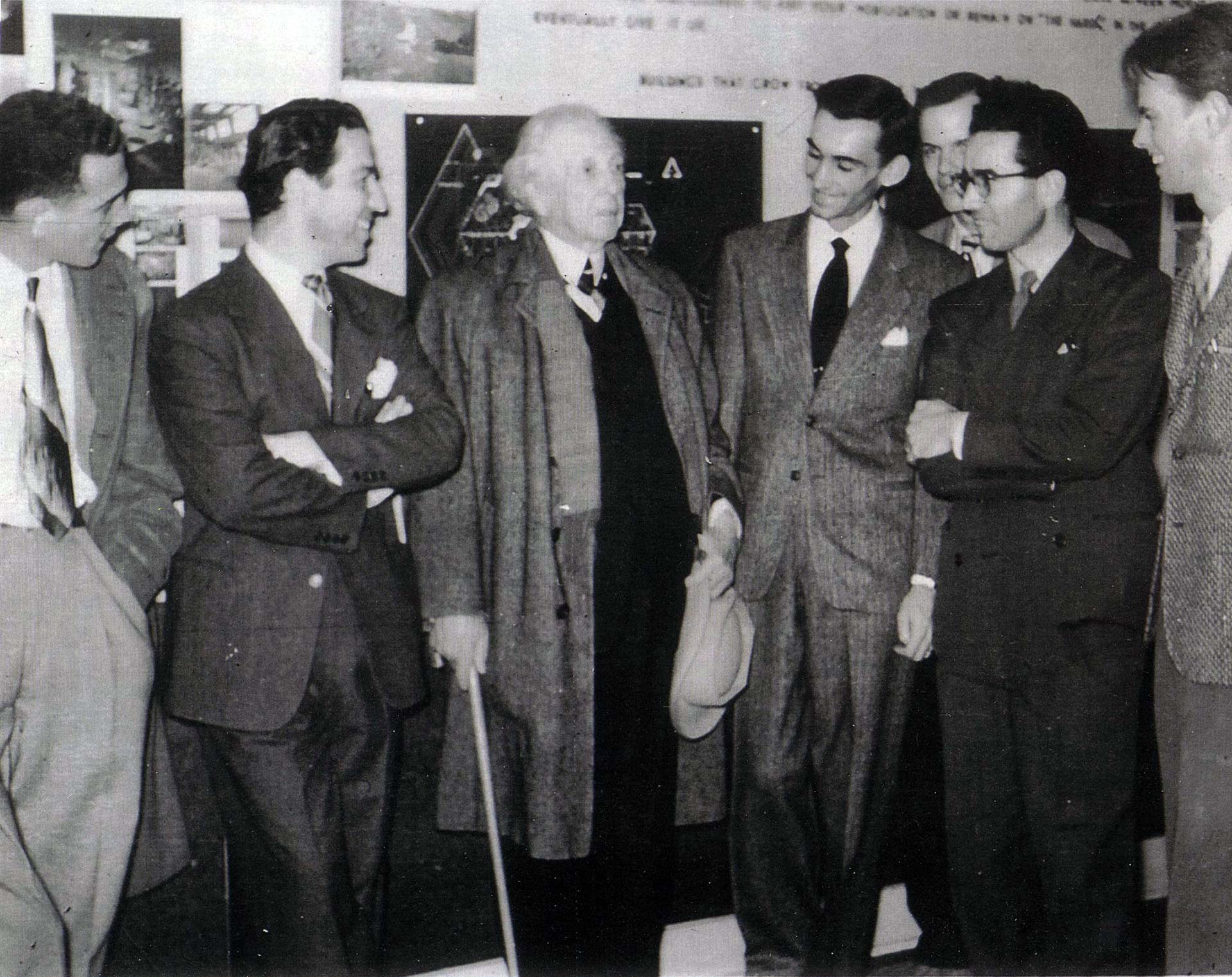
Frank Lloyd Wright with a group of students at the DU School of Architecture, captured during a visit where he shared his insights and ideas on modern architecture. Image Source: Wikimedia Commons. License: Public domain.
“I know the price of success: dedication, hard work, and an unremitting devotion to the things you want to see happen.” — Frank Lloyd Wright
Notable mentees, such as John Lautner, Richard Neutra, and E. Fay Jones, all carried Wright’s principles into their own practices, creating a ripple effect across the architecture world. Lautner’s futuristic homes in Los Angeles, such as the Sheats-Goldstein Residence, pushed the boundaries of organic design in urban environments. Richard Neutra became known for his sleek, modernist homes that seamlessly blended indoor and outdoor spaces, while E. Fay Jones, with his ethereal Thorncrown Chapel, demonstrated a mastery of light and natural materials that echoed Wright’s own reverence for nature. “Frank was relentless in his pursuit of creativity,” Lautner once said. “He taught us to view the world through a different lens—to see nature as the ultimate guide for design.”
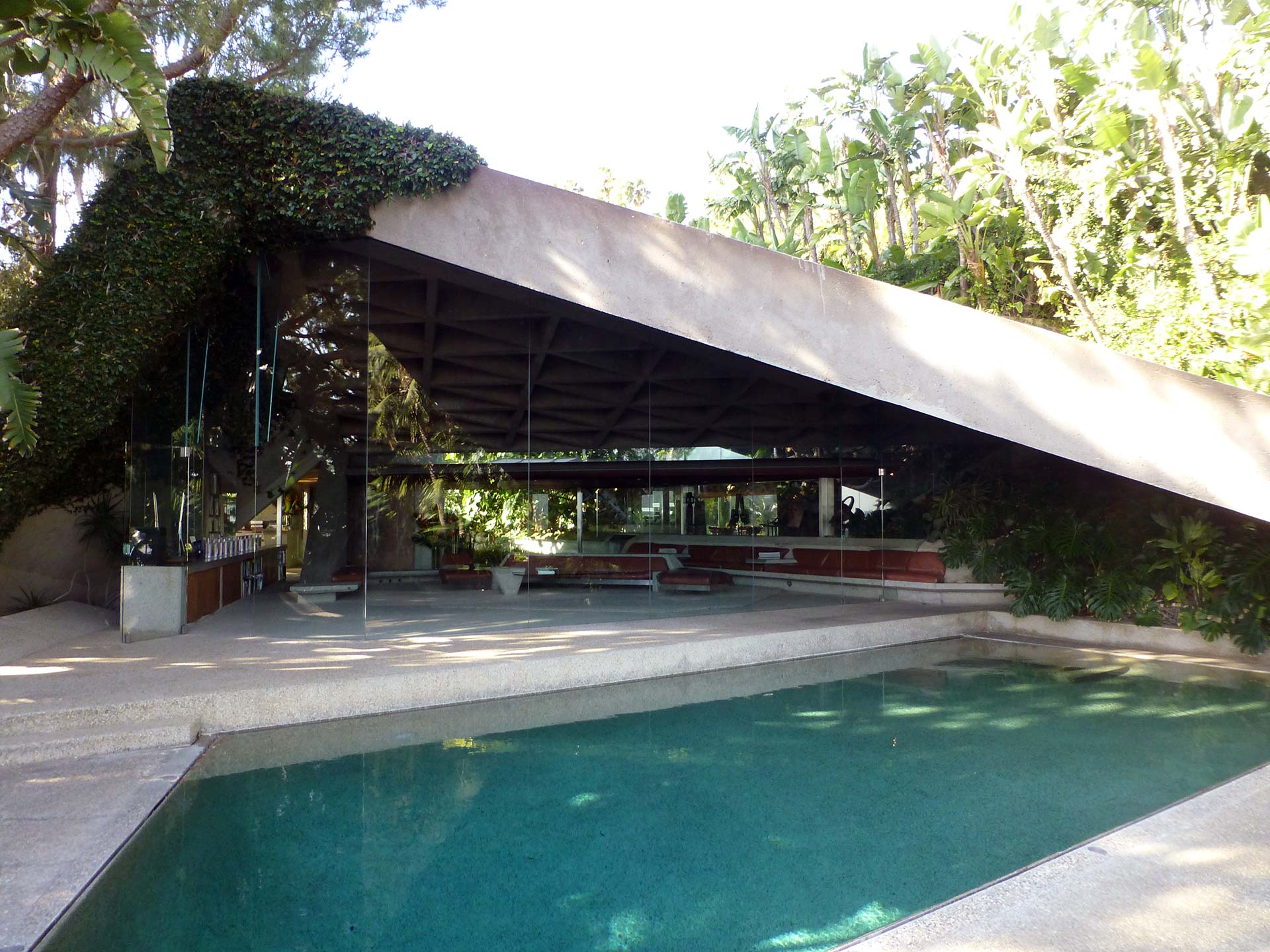
The Sheats-Goldstein Residence in Los Angeles, designed by architect John Lautner in 1963, is renowned for its organic design and integration with the surrounding landscape. Image Source: Wikimedia Commons. License: Creative Commons Attribution-Share Alike 4.0 International (CC BY-SA 4.0).
Wright’s mentorship was about more than teaching architectural skills; it was about instilling a creative spirit. His students were encouraged to think for themselves, to challenge conventions, and to explore new forms of expression. This influence extended beyond architecture, touching disciplines like interior design, landscaping, and even product design. What’s surprising about Wright’s mentorship is how it fostered innovation in unexpected ways. He encouraged his students to explore creative fields outside of architecture. George Nakashima, a renowned furniture designer who briefly worked with Wright, credited him with inspiring his approach to woodworking, creating pieces that felt as if they grew organically from the material itself.
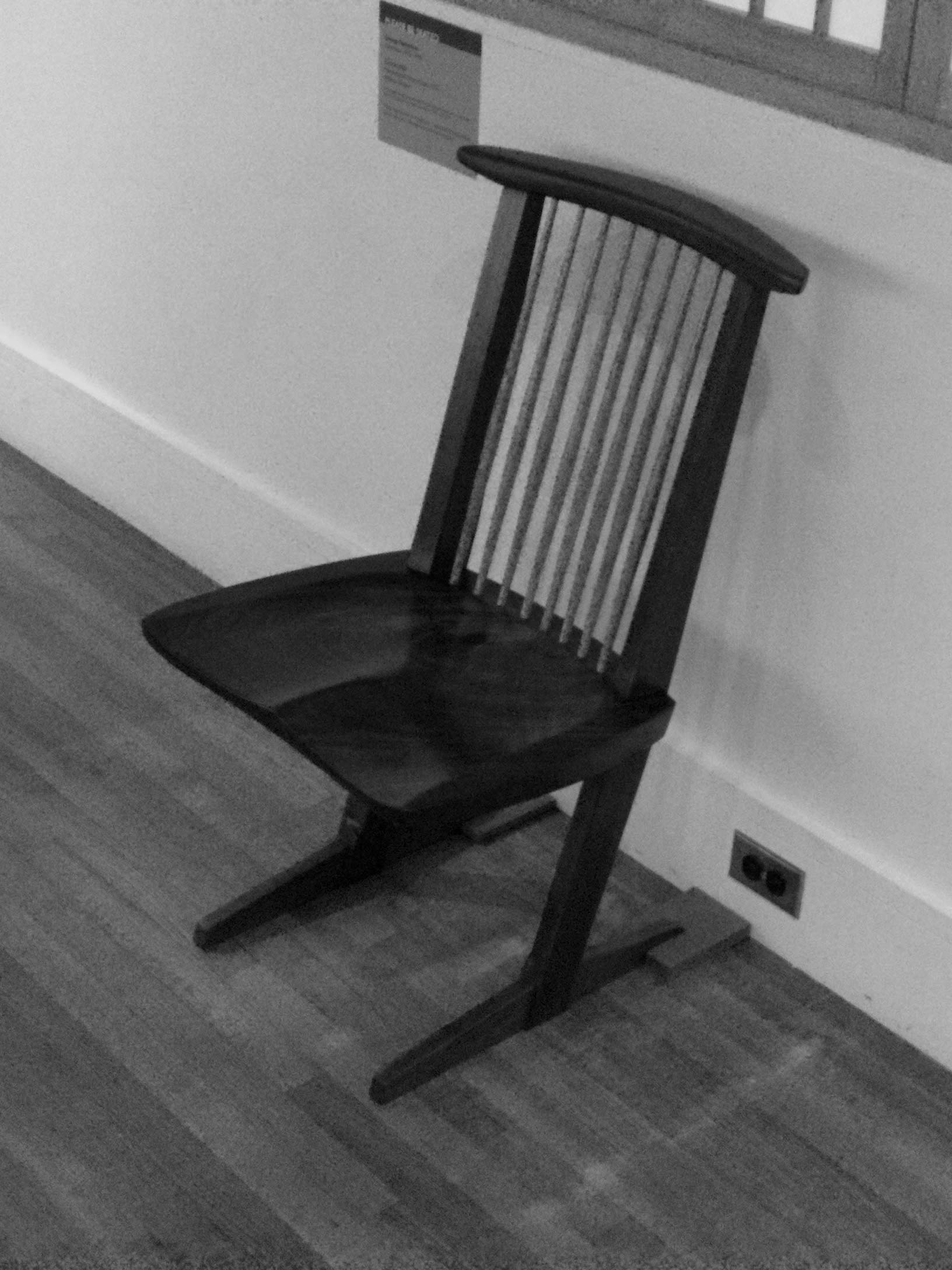
A chair designed by renowned woodworker George Nakashima, reflecting his dedication to craftsmanship and the natural beauty of wood. Image Source: Wikimedia Commons. License: Creative Commons Attribution-Share Alike 4.0 International (CC BY-SA 4.0).
Today, Wright’s legacy as a mentor is still felt. Architects like Zaha Hadid and Norman Foster have acknowledged Wright’s influence on their own work. Foster once remarked, “Wright showed us that to be a great architect, you have to be more than just a designer—you have to be a philosopher, a teacher, a visionary.” At RIOT, we carry forward this same philosophy of mentorship and creative growth. Just as Wright cultivated the talents of his protégés, RIOT seeks to mentor emerging creatives, helping them find their own voice while drawing inspiration from the past. Our commitment to nurturing creativity ensures that each generation of RIOT team members continues to push the boundaries of what’s possible in design, media, and branding.
Frank Lloyd Wright’s Enduring Legacy
Frank Lloyd Wright’s influence on architecture and design is immeasurable. His work didn’t just change the way buildings were constructed—it changed the way people thought about space, function, and the relationship between humans and their environment. His ideas about organic architecture, modular design, and holistic living environments laid the foundation for much of modern architecture, and his impact can still be seen in buildings across the globe.
One of the most enduring aspects of Wright’s legacy is how his work transcends time. Buildings like the Guggenheim Museum or Fallingwater are still hailed as revolutionary, not just for their aesthetic beauty but for the way they challenge traditional ideas of form and function. The Guggenheim, with its spiraling ramp and open rotunda, breaks all the rules of museum design, creating a dynamic, fluid space that guides visitors through the art in an entirely new way. It remains a testament to Wright’s ability to think beyond the confines of conventional design.
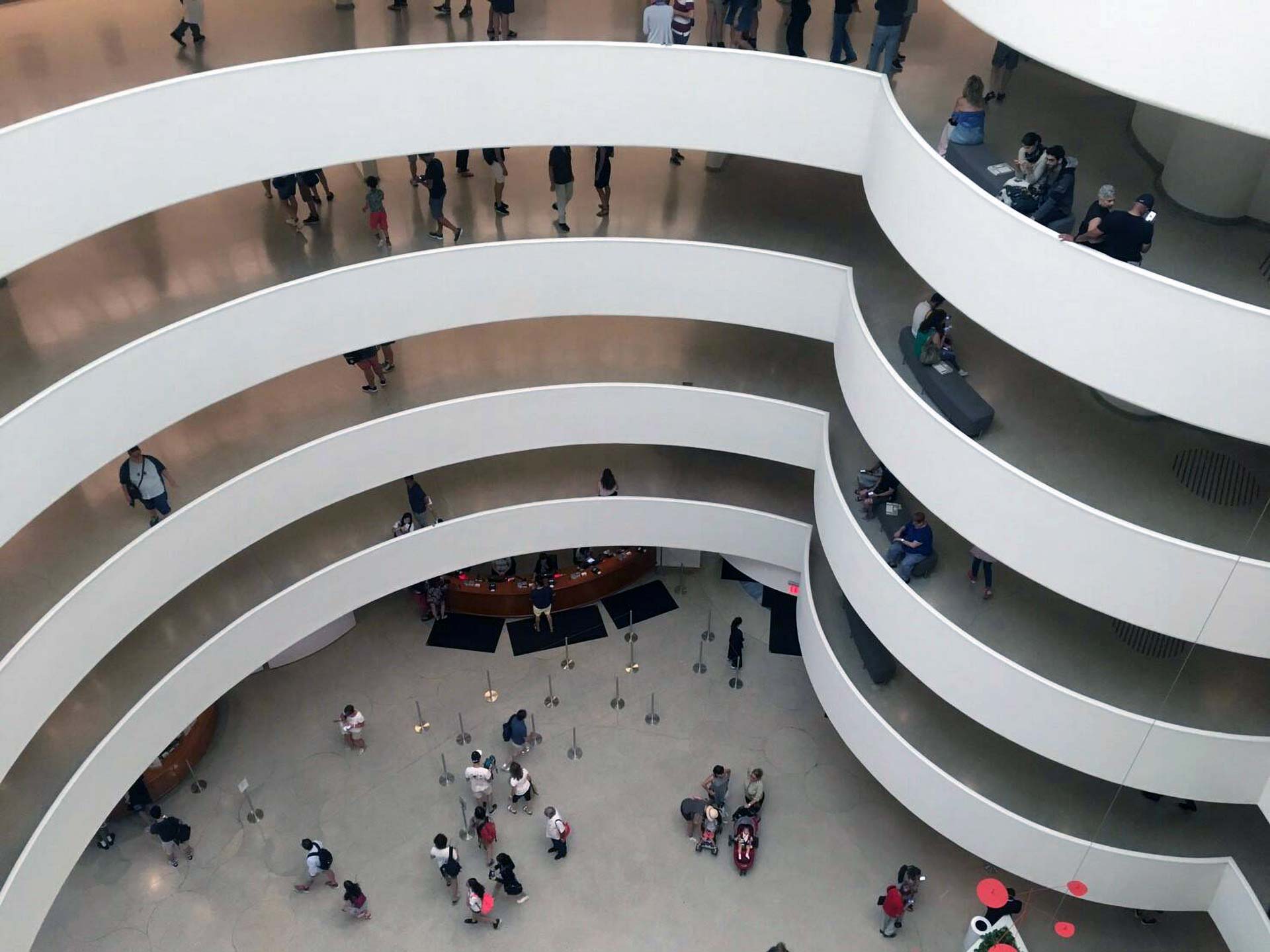
The interior of the Solomon R. Guggenheim Museum in New York City, designed by Frank Lloyd Wright, features the famous spiraling ramps that lead visitors through the museum’s art galleries. Image Source: Wikimedia Commons. License: Creative Commons Attribution-Share Alike 4.0 International (CC BY-SA 4.0).
“Every great architect is necessarily a great poet. He must be a great original interpreter of his time, his day, his age.” — Frank Lloyd Wright
What may surprise many is how relevant Wright’s ideas about sustainability are today. His belief in integrating buildings with their surroundings, using local materials, and designing energy-efficient structures was ahead of his time. Wright’s Usonian homes, for example, were designed to be affordable and eco-friendly, with passive solar heating and natural ventilation systems. His use of natural light, large windows, and open floor plans helped reduce the need for artificial lighting and heating, concepts that are central to today’s green building movement.
In recent years, Wright’s work has been cited as a precursor to the biophilic design movement, which emphasizes creating spaces that connect people with nature. Wright’s insistence that “nature is the architect’s greatest teacher” resonates deeply with today’s architects who seek to create sustainable, environmentally friendly buildings. Wright’s influence has only grown in the years since his death. Many of today’s leading architects consider themselves part of Wright’s creative lineage. Renzo Piano, for example, known for his innovative use of materials and light, has said, “Wright showed us that architecture could be more than shelter—it could be art.”
Wright’s legacy also extends beyond architecture. His influence can be seen in everything from furniture design to filmmaking. Director Christopher Nolan used Wright’s buildings as inspiration for the dreamscapes in his film Inception, while Wright’s Ennis House has appeared in films like Blade Runner, further cementing his work’s impact on visual storytelling. Virgil Abloh once stated, “Wright taught us that creativity isn’t confined to one discipline. His work was a blueprint for how to blur the lines between art, architecture, and design.”
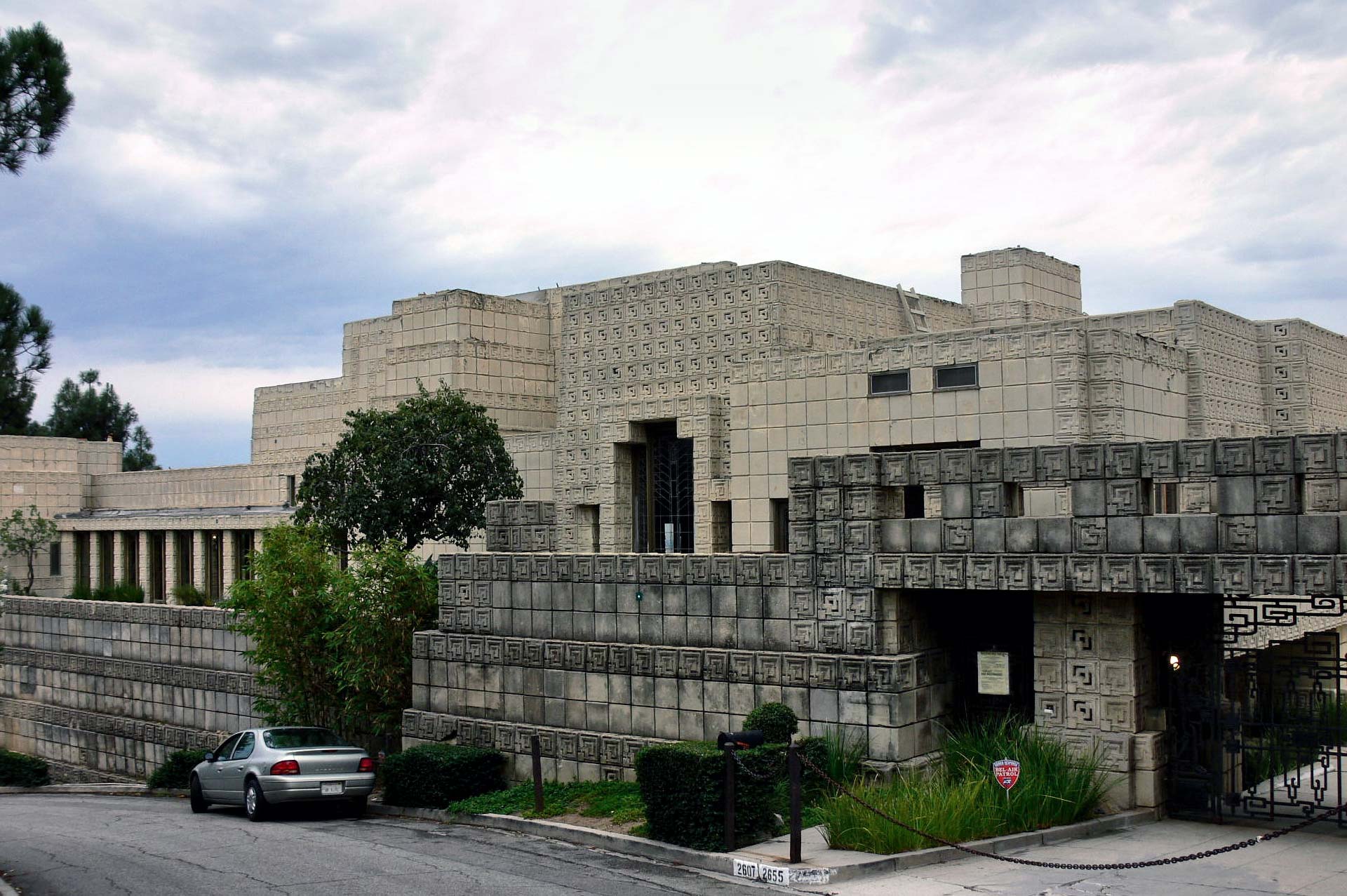
The Ennis House, designed by Frank Lloyd Wright and completed in 1924 in Los Angeles, California, is renowned for its Mayan Revival style and intricate concrete block construction. Image Source: Wikimedia Commons. License: Public domain.
Frank Lloyd Wright’s Enduring Influence on Creativity
Frank Lloyd Wright was more than just an architect; he was a creative visionary whose work continues to inspire generations of architects, designers, and artists. His relentless pursuit of innovation, his belief in organic design, and his dedication to mentoring future creatives have left a lasting legacy that transcends time and discipline.
Today, Wright’s influence is felt not only in the buildings he designed but in the way we think about creativity itself. His work serves as a reminder that great design is about more than function—it’s about creating environments that inspire, provoke, and elevate the human experience.
At RIOT, we carry forward this belief in the power of creativity to shape the world. Like Wright, we strive to push boundaries, foster innovation, and mentor the next generation of creatives, ensuring that the spirit of design and creativity continues to thrive.




